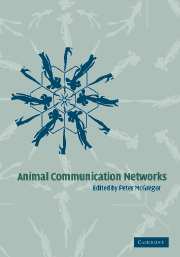Book contents
- Frontmatter
- Contents
- List of contributors
- Preface
- 1 Introduction
- Part I Behaviours specific to communication networks
- Part II The effects of particular contexts
- Part III Communication networks in different taxa
- Introduction
- 12 Waving in a crowd: fiddler crabs signal in networks
- 13 Anuran choruses as communication networks
- 14 Singing interactions in songbirds: implications for social relations and territorial settlement
- 15 Dawn chorus as an interactive communication network
- 16 Eavesdropping and scent over-marking
- 17 Vocal communication networks in large terrestrial mammals
- 18 Underwater acoustic communication networks in marine mammals
- 19 Looking for, looking at: social control, honest signals and intimate experience in human evolution and history
- Part IV Interfaces with other disciplines
- Index
13 - Anuran choruses as communication networks
Published online by Cambridge University Press: 06 August 2010
- Frontmatter
- Contents
- List of contributors
- Preface
- 1 Introduction
- Part I Behaviours specific to communication networks
- Part II The effects of particular contexts
- Part III Communication networks in different taxa
- Introduction
- 12 Waving in a crowd: fiddler crabs signal in networks
- 13 Anuran choruses as communication networks
- 14 Singing interactions in songbirds: implications for social relations and territorial settlement
- 15 Dawn chorus as an interactive communication network
- 16 Eavesdropping and scent over-marking
- 17 Vocal communication networks in large terrestrial mammals
- 18 Underwater acoustic communication networks in marine mammals
- 19 Looking for, looking at: social control, honest signals and intimate experience in human evolution and history
- Part IV Interfaces with other disciplines
- Index
Summary
Introduction
It is becoming more and more apparent that communication often takes place in a network of several signallers and receivers (as shown by most of the chapters in this volume and reviewed by McGregor & Peake (2000)). The network view of communication stresses that signallers and receivers have additional costs and benefits to those usually found in dyadic interactions. For example, in communication networks signallers often face the problem of intense intra- and interspecific competition whereas receivers must discriminate information from individuals under conditions of high background noise.
In many frogs and toads, males aggregate in large choruses to advertise for females. The signals they use are conspicuous and long range; therefore, choruses constitute a classic example of a communication network. The challenge of communicating in such large choruses is to balance the costs and benefits of attracting a mate, repelling rivals and avoiding predators and/or parasites. Consequently, advertising in choruses will have far-reaching effects on vocal behaviour. If we want to understand signal design and signalling behaviour in such aggregations, we need to look at communication in the network context in which these different selective pressures operate.
In this chapter, I will review why it is important to investigate communication in chorusing anurans within the network environment. I will focus on the behaviour of both signallers and receivers. First, I will discuss patterns of male–male vocal competition that can best be understood within the network environment.
- Type
- Chapter
- Information
- Animal Communication Networks , pp. 277 - 299Publisher: Cambridge University PressPrint publication year: 2005
- 26
- Cited by

